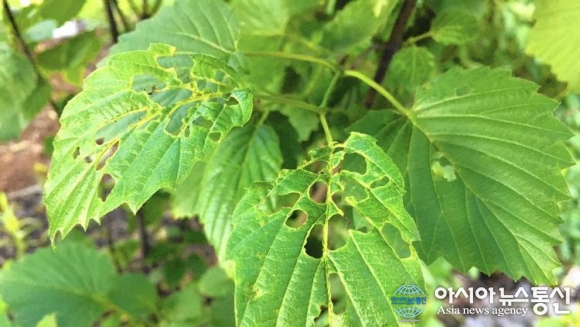 |
Have the leaves of your viburnum shrubs turned to lace?If so, they are likely infested with viburnum leaf beetles, according to Sharon Yiesla, plant knowledge specialist at the Plant Clinic of The Morton Arboretum in Lisle.
"You'll see the damage before you see the insect," Yiesla said.The pale yellow or green larvae that hatch and feed in spring are only 1/3-inch long, and the brown adult beetles that emerge in late June or July are even smaller.At both life stages, the insect chews away the tissue between the veins of a leaf, leaving just a skeleton.
This pest feeds exclusively on viburnum shrubs, although some species are more susceptible than others.Arrowwood viburnum (Viburnum dentatum) seems to be especially vulnerable.An infestation that lasts two or three years can kill a susceptible shrub, Yiesla said.Though this is a relatively new pest in the Chicago area, it seems to be widespread this year, she said.
You can attack this insect at three life stages: as a larva, as an adult beetle or as an egg.Depending on when you take action, you will need different approaches.
The first opportunity is when the larvae are feeding, between late April and early June, depending on each year's weather.If you spot them then, you may be able to kill them with a spray of insecticidal soap.However, gardeners often don't notice the damage until the larval stage is over.
When the adult beetles emerge in late June or early July, they are harder to kill.
"It probably will take a serious insecticide to kill adult beetles," Yiesla said.
There are risks: Those pesticides also threaten beneficial insects, such as bees and predatory insects that might eat the larvae and adult beetles.Before you use an insecticide, consult the Arboretum's Plant Clinic for specific advice, and follow the instructions to the letter.
Your best chance to battle viburnum leaf beetles without spraying is by pruning in winter to remove the tender branch tips where the female beetles have laid their eggs.
"Once the shrubs are dormant, it's fairly easy to spot the egg masses and prune them out," Yiesla said.
The egg masses are small, dark, football-shaped lumps lined up along the undersides of twigs.You may see them as early as September, but it's best to prune when the shrubs are dormant, between November and February.Snip out every twig or branch that has an egg mass.Be careful to collect all the snippings and destroy them.Don't put any twigs in your compost; the eggs are likely to survive and hatch.
Pruning out the egg masses can keep the insect population low enough to save a viburnum, Yiesla said, although if you have several large shrubs or a viburnum hedge, it may not be practical.
"In the long run, you may need to plant a new viburnum," she said.Some species that rarely show damage from viburnum leaf beetle include Koreanspice viburnum (Viburnum carlesii), doublefile viburnum (Viburnum plicatum) and Judd viburnum (Viburnum juddii).
 |
| Photo by: Hectonichus / Wikimedia Commons |














